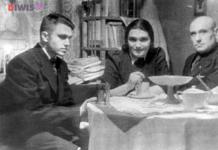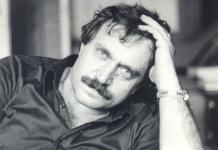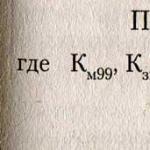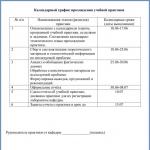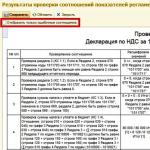◊ The rating is calculated based on points awarded over the last week
◊ Points are awarded for:
⇒ visiting pages dedicated to the star
⇒voting for a star
⇒ commenting on a star
Biography, life story of Maya Carmen (Aksyonova)
Maya Afanasyevna Karmen (Aksenova) is the second and last wife of the writer.
Childhood and youth
Maya was born in Moscow on June 5, 1930 in the family of Afanasy Andreevich Zmeul, a Soviet historian and hero of the civil war. After school, Maya entered the All-Union Academy of Foreign Trade (at that time it was headed by her father), after which she began working at the Chamber of Commerce.
Maya Zmeul was a typical representative of the “golden youth”. Thanks to her father's money and connections, she got everything she wanted. After the death of her mother, her stepmother came to her house, with whom she developed a warm relationship.
Husbands
In 1951, Maya married Maurice Ovchinnikov, a foreign trade worker. In 1954, the couple had a daughter, Elena. Alas, the relationship between Maya and Maurice did not work out. After several years of marriage, they decided to file for divorce.
Maya's second husband was director Roman Carmen. With him, Maya lived in grand style - a luxurious apartment, a dacha near Moscow, regular trips abroad, cars with personal drivers at any time of the day, an elite social circle. And all this against the backdrop of sincere and incredibly strong love for each other. It would seem that the union of Maya and Roman is indestructible. But in 1970 everything changed. The Carmen couple went to Yalta (Roman needed to recover his health after a heart attack), where Maya met. This meeting changed her whole life.
Maya and fell in love at first sight. At that time they were both married. Secret dates began, kisses were stolen... But, as you know, sooner or later everything secret becomes clear. Despite the fact that Maya’s affair became public knowledge, the lovers did not take any action. Maya could not leave her husband, and did not dare to persuade her against her will. In 1978, when Roman Carmen died, Maya had no choice but to try to start a family with. Soon he divorced his then-wife Kira. In 1980, Maya got married.
CONTINUED BELOW
Life in the USA
Immediately after the wedding, the Aksenov family, including Elena, Maya’s daughter from her first marriage, and her son Ivan, went to Paris. From there the family moved to America, planning to stay there for a couple of years. But due to the unexpected deprivation of citizenship, they had to stay in a foreign land for 24 years. In the USA, Maya Aksenova taught Russian to university students.
A series of tragedies
In 1999, a terrible grief occurred in the Aksenov family. Maya Aksenova’s grandson Ivan died tragically. A 26-year-old boy accidentally fell out of a window. The misfortunes did not end there. In 2004, the couple returned to their Moscow apartment, and in 2008 they suffered a stroke.
The Soviet writer, playwright Vasily Pavlovich Aksyonov, whose biography, personal life and creative path we will consider in our article today, was a truly extraordinary and courageous person. He carried his free thoughts to the masses, without regard for prohibitions, which greatly irritated those in power. He was loved, he was admired, he was banned. But he never stopped writing.
The future world-famous playwright was born on August 20, 1932 in the city of Kazan. His childhood occurred during the most difficult time for our country. And already as a five-year-old child, Vasily learned what separation from loved ones was.
In 1937, during the Stalinist campaign to expose the “cult of personality,” both of the boy’s parents were arrested and sent to camps until 1947. And if the father, Pavel Vasilyevich Aksenov, had a rather distant relationship with culture and art. Then mother Evgenia Ginzburg, who first taught at a pedagogical university, and then took charge of the cultural department of a local newspaper, was, according to the authorities, the first candidate for Stalin’s camps.
Vasya was the least fortunate in this terrible story, because unlike his half-sister Maya and brother Alexei, who were taken by their closest relatives, he, as the only common child of the prisoners, was unconditionally sent to an orphanage. And only a year later his paternal uncle, Andriyan Vasilyevich, found the child and took him to him.

Vasily lived in the house of his uncle and his wife until his mother, who was in exile in Magadan after prison, received permission for the heir to come to her. A few years later, Evgenia Solomonovna Ginzburg will talk about this meeting in her book of memoirs, “Steep Route.” And a few more decades later, in 1975, already a famous writer, Vasily Aksyonov himself will talk about his harsh youth in the autobiographical novel “Burn”.

In 1951, Vasily Pavlovich entered one of the leading Leningrad medical universities, which he graduated brilliantly 5 years later. This allowed him to receive assignment to long-distance ships, which he was supposed to accompany as a full-time doctor. Then young Vasily was incredibly happy about such a rare opportunity, because the whole world was open to him. However, it was then that he received his first “poke” from the Soviet authorities, who never gave him access to his dream job. Although Aksyonov’s parents had already been rehabilitated at that time.
And so it happened that instead of new countries, the young man was forced to go north to work there as a quarantine doctor. But after some time he was lucky enough to find a place in Moscow, where he immediately moved.
Creation
The beginning of Vasily Aksenov’s creative biography dates back to 1959-1960. It was then that the story “Colleagues” came out from his pen, which was accepted for publication and made the aspiring author famous throughout the USSR. Then other works of the writer see the light of day. And below we list the most significant of them.



- He also has children's works to his credit. For example, “My Grandfather the Monument” and “The Chest in which Something is Knocking,” published in the 70s. During the same period, the author experimented with the historical and biographical genre, coming up with the work “Love of Electricity,” which was dedicated to the Russian revolutionary Krasin.

- Vasily Pavlovich Aksyonov was also involved in book translations.

It should be noted that the creative path of the writer Aksenov was not so cloudless. Despite the fact that the Soviet reader clearly liked his stories, novels and short stories, and literary magazines and publishing houses willingly published them, the authorities were not always happy with the works of Vasily Pavlovich.

For example, in 1963, at a spring meeting with the Soviet intelligentsia, the country's leader Nikita Khrushchev gave Aksyonov a “demonstrative flogging.” As it turned out, Nikita Sergeevich was sure that the writer’s works emanated dissidence, and in general, all his books went against the policies of the USSR.

And, it should be noted that Khrushchev was not so wrong. After all, the writer really did not agree with the current government on many issues, which forced him, along with other cultural figures, to go to the Kremlin walls and organize pickets. As a result, all this led to the fact that in 1980 Aksenov became an emigrant.
Emigration
Having received an invitation to the United States, the writer decided to move there. And immediately after that he was deprived of citizenship of the Soviet Union, which Aksyonov was able to return only many years later. In exile, Vasily Pavlovich taught literature in the best educational institutions in America, and also worked as a correspondent for radio stations.

He did not forget about writing. Then several books came out from his pen, the most striking of which were “The Decade of Slander” and “The Moscow Saga,” which became the script for a series filmed in the early 2000s.

In the early nineties, Aksenov regained his Russian citizenship. However, he was in no hurry to return home, deciding to settle in France.
Personal life
Vasily Aksenov did not forget to arrange his personal life, because even from the photo it is clear that he was a very charming man.
The writer created a family twice. His first wife was Kira Mendeleeva, an intelligent and highly educated girl from a good family. They met in 1956 and got married 6 months later. And in 1960, Kira gave birth to Vasily’s son Alexei. The famous writer had no more children.

Vasily Pavlovich met his second wife Maya Carmen in the mid-sixties. At that time, Maya was the wife of director Roman Carmen. However, the relationship between her and the writer arose at lightning speed. The ensuing romance led to conflicts in both families and Aksyonov’s divorce. And in 1980, after the death of director Carmen, the couple got married. Soon they flew to the USA, after which they lost the right to return to Russia. The situation was corrected only in 2004.

The couple lived together until Aksyonov’s death in 2009.
Death
In January 2008, the famous writer suffered a stroke. To save his life, at the Research Institute named after. Sklifosovsky Aksenov underwent surgery. However, this did not help improve his condition. He was in a coma for a long time.

In the spring of 2009, the writer underwent a second operation, which also did not bring improvement, and on July 6 of the same year, after a long illness, Vasily Pavlovich died.

He was buried at the Vagankovskoye cemetery in the capital.
Maya Carmen (Aksenov’s wife) celebrated her 86th birthday on June 5, 2016. In her youth, she was the stubborn, straightforward and purposeful daughter of the Soviet historian A. A. Zmeul, who in the 33rd year of the World War II, and during the Second World War worked as a PUR agitator, then headed the International Book organization.
Early life
Maya Zmeula, being a representative of the “golden youth”, graduated from the capital’s school and foreign trade institute, and worked at the Chamber of Commerce. In contrast to what the daughter of a foreign trade executive who heads a large international organization had, she was left without a mother. Afanasy married for the second time. But the girl did not seek to build a relationship with her stepmother.
In 1951, her first marriage took place with foreign trade worker Maurice Ovchinnikov. Three years later, a daughter, Lena, appeared in the family. But the meeting with the famous director Carmen became fatal. Roman left Nina Orlova after 20 years of marriage.

Possessing a prestigious apartment in a popular high-rise building on Kotelnicheskaya Embankment, a dacha near Moscow, a car with personal drivers, the couple lived in peace and harmony. They could afford expensive travel and hours-long receptions with Politburo members.
But in the 1970s, Carmen was diagnosed with a heart attack. The couple decided to restore their health in Yalta, where Maya met with Vasily Aksenov.

Life with Aksenov
At that time Maya and Vasily met, they were married. This did not stop them from meeting secretly and becoming the subject of public discussion. Maya did not have the right to leave her husband, and Aksyonov did not contradict her will. In 1978, Roman Carmen died, and Maya decided to try her luck with Vasily. This influenced the divorce from his wife Kira. And 2 years later the wedding celebration took place. The event took place in Peredelkino, at the dacha, in the circle of close people.

In July 1980, the family went to France. After 2 months, they visited the USA, where they decided to stay for 2 years. But with the deprivation of citizenship, the writer remained to live abroad for 24 years. Maya and her husband worked as philologists at the university.
In 1999, Carmen lost her grandson Vanya. He broke, falling out of the window. At this time he was 26 years old.

In 2004, the Aksenovs were returned to their seized housing in the capital of the Russian Federation. Four years later, the head of the family had a stroke when he was traveling outside the high-rise building. The man lay in a coma for 2 years. And in 2008, daughter Lena died unexpectedly in her sleep, followed by her stepfather.
In one of the interviews, Carmen admits that she lives for her beloved dog Aksenov, a spaniel with the nickname Pushkin.
Video
Aksenov Vasily Pavlovich is a well-known Russian writer in wide circles. His works, imbued with the spirit of freethinking, tough and touching, sometimes surreal, do not leave any reader indifferent. The article will examine the biography of Vasily Aksenov and provide a list of his most interesting literary works.
Early years
In 1932, on August 20, in the city of Kazan, a son, Vasily, was born to Pavel Aksenov, chairman of the Kazan City Council, and Evgenia Ginzburg, a teacher at the Kazan Pedagogical Institute. According to the family, he was already the third child, but the only one they shared. When the boy was not yet five years old, both parents (first his mother, then his father) were arrested and then sentenced to ten years in prison each. Having gone through Stalin’s camps, he would later publish a book of memoirs about the era of repression, “Steep Route,” which tells the story of eighteen years spent in prisons, exile, and Kolyma camps. But this is not about that now, we are interested in the biography of Vasily Aksenov.
After the imprisonment of the parents of the older children - Alyosha (son of Evgenia Ginzburg) and Maya (daughter of Pavel Aksenov) - they were taken into care by relatives. And Vasya was forcibly sent to an orphanage for children of convicts (the boy’s grandmothers wanted to keep him with them, but they were not allowed to do so). In 1938, Pyotr Aksenov’s brother, Andreyan, found the child in the Kostroma orphanage and took him to him. Until 1948, Vasya lived with a paternal relative, Moti Aksenova, until the boy’s mother, released from prison in 1947, obtained permission for her son to move to her in Kolyma. Later, the writer Vasily Aksenov will describe his Magadan youth in the novel “Burn”.
Education and work
In 1956, the guy graduated from the Leningrad Medical Institute and was assigned to work as a doctor at the Baltic Shipping Company on long-distance vessels. However, he was not given access, despite the fact that his parents had been rehabilitated by that time. There is information that Vasily Aksenov worked as a quarantine doctor in Karelia, in the Far North, in the Moscow tuberculosis hospital (according to other information, he was a consultant at the Tuberculosis Research Institute in Moscow), as well as in the sea trade port of Leningrad.

Beginning of literary activity
Aksenov can be considered a professional writer since 1960. In 1959, he wrote the story “Colleagues” (a film of the same name was made based on it in 1962), in 1960 - the work “Star Ticket” (the film “My Little Brother” was also based on it in 1962), two years later - the story “Oranges from Morocco”, and in 1963 - the novel “It’s time, my friend, it’s time.” Then Vasily Aksenov’s books “Catapult” (1964) and “Halfway to the Moon” (1966) were published. In 1965, the play “Always on Sale” was written, which was staged on the stage of Sovremennik the same year. In 1968, the story of the satirical-fantasy genre “Overstocked Barrel” was published. In the sixties of the twentieth century, the works of Vasily Aksenov were published quite often in the magazine “Youth”. The writer worked on the editorial board of this publication for several years.
Seventies
In 1970, the first part of the adventure duology for children “My Grandfather is a Monument” was published, in 1972 the second part - “The Chest in which Something Knocks” was published. In 1971, the story “Love of Electricity” (about Leonid Krasin), written in the historical and biographical genre, was published. A year later, an experimental work entitled “Search for a Genre” was published in the New World magazine. In 1972, the novel “Gene Greene - Untouchable” was also created, which is a parody of an action film about spies. Vasily Aksenov worked on it together with Grigory Pozhenyan and Oleg Gorchakov. The work was published under the authorship of Grivadiy Gorpozhaks (a pseudonym from a combination of the surnames and names of three writers). In 1976, the writer translated the novel “Ragtime” by Edgar Lawrence Doctorow from English.
Social activities
The biography of Vasily Aksenov is filled with difficulties and hardships. In March 1966, while participating in an attempted demonstration against the intended rehabilitation of Stalin in Moscow, on Red Square, the writer was detained by vigilantes. Over the next two years, Aksenov put his signature on a number of letters sent in defense of dissidents, and was reprimanded for this by the Moscow branch of the Union of Writers of the USSR and included in the file.

Nikita Khrushchev, at a meeting with the intelligentsia back in 1963, sharply criticized Vasily Aksenov and Andrei Voznesensky. When the “thaw” ended, the writer’s works were no longer published in his homeland. In 1975, the novel “The Burn,” which we have already mentioned, was written. Vasily Aksenov did not even hope for its publication. “Island of Crimea” - a novel in the fantasy genre - was also initially created by the author without the expectation that the work would be published and seen by the world. At this time (1979), criticism towards the writer became more and more acute, epithets such as “anti-people” and “non-Soviet” began to creep into it. But in 1977-1978, Aksenov’s works began to appear abroad, mainly in the United States of America.
Together with Iskander Fazil, Bella Akhmadulina, Andrey Bitov and Evgeny Popov, Vasily Aksenov became the co-author and organizer of the Metropol almanac in 1978. It never made it into the Soviet censored press, but it was published in the USA. After this, all participants in the almanac underwent “workouts.” This was followed by the expulsion of Erofeev and Popov from the Union of Writers of the USSR, and as a sign of protest, Vasily Aksenov, together with Semyon Lipkin and Inna Lisnyanskaya, also announced their withdrawal from the joint venture.
Life in the USA
At the invitation, in the summer of 1980, the writer went to the United States, and in 1981, for this, his USSR citizenship was taken away. Aksenov lived in the USA until 2004. During his stay there, he worked as a professor of Russian literature at various American universities: the Kennan Institute (from 1981 to 1982), the University of Washington (from 1982 to 1983), Goucher College (from 1983). to 1988), Mason University (from 1988 to 2009). As a journalist from 1980 to 1991. Aksenov Vasily collaborated with radio stations Radio Liberty, Voice of America, the almanac "Glagol" and the magazine "Continent". The writer’s radio essays were published in the collection “A Decade of Slander,” published in 2004.

In the United States, works written but not published in Russia were published: “The Burn”, “Our Golden Iron”, “The Island of Crimea”, and the collection “The Right to the Island”. However, Vasily Aksenov continued to create in America: “The Moscow Saga” (trilogy, 1989, 1991, 1993), “The Negative of a Positive Hero” (collection of stories, 1995), “The New Sweet Style” (a novel dedicated to the life of Soviet emigrants in the USA, 1996) - all this was written while living in the United States. The writer created works not only in Russian; in 1989, the novel “Egg Yolk” was written in English (however, it was later translated by the author himself). At the invitation of Jack Matlock, the American ambassador, Aksenov came to the Soviet Union for the first time after going abroad (nine years later). In 1990, the writer was returned to Soviet citizenship.
Work in Russia
In 1993, during the dispersal of the Supreme Soviet, Vasily Aksenov again openly showed his convictions and expressed solidarity with the people who signed a letter in support of Yeltsin. In 2004, Anton Barshchevsky filmed the Moscow Saga trilogy in Russia. In the same year, the magazine “October” published the writer’s work “The Voltairians and Voltairians,” which was subsequently awarded. In 2005, Aksenov wrote a book of memoirs in the form of a personal diary entitled “The Apple of his Eye.”

Last years of life
In his last years, the writer and his family lived either in France, in the city of Biarritz, or in Moscow. In the Russian capital, on January 15, 2008, Aksenov felt unwell and was hospitalized in the writer. The writer was diagnosed with a stroke. A day later, Vasily Pavlovich was transferred to the Sklifosovsky Research Institute, and he underwent surgery to remove a blood clot in the carotid artery. For a long time, the writer’s condition remained quite serious. And in March 2009, new complications appeared. Aksenov was transferred to the Burdenko Institute and operated on again. Then Vasily Pavlovich was again hospitalized in It was there that the writer died on July 6, 2009. Vasily Pavlovich was buried in Moscow, at the Vagankovskoye cemetery. In November 2009, in Kazan, in the house where the writer once lived, a Museum of his work was organized.
Vasily Aksenov: “Mysterious passion. A novel about the sixties"
This is the last completed work of the talented writer. It was published in full after Aksenov’s death, in October 2009. Prior to this, in 2008, individual chapters were published in the publication “Collection of the Caravan of Stories.” The novel is autobiographical, its heroes are the idols of art and literature of the sixties of the twentieth century: Evgeny Yevtushenko, Bulat Okudzhava, Andrei Voznesensky, Ernst Neizvestny, Robert Rozhdestvensky, Bella Akhmadulina, Marlen Khutsiev, Vladimir Vysotsky, Andrei Tarkovsky and others. Aksenov assigned fictitious names to the characters so that the work would not be associated with the memoir genre.

Prizes, awards, memory
In the United States of America, the writer was awarded the degree of Doctor of Humanities. He was also a member of the American Authors League and PEN Club. In 2004, Aksenov was awarded the Russian Booker Prize for his work “The Voltaireans and the Voltairians.” A year later he was awarded the honorary Order of Arts and Letters. The writer was a member of the Russian Academy of Arts.
Every year since 2007, a literary and musical international festival called “Aksenov Fest” has been held in Kazan. For the first time it was held with the personal participation of Vasily Pavlovich. In 2009, the literary House-Museum of the famous writer was opened, and a literary city club now operates there. In 2010, the autobiographical unfinished novel of the writer “Lend-Lease” was published. Its presentation took place on November 7 at the Vasily Aksenov House-Museum.
In 2011, Evgeny Popov and Alexander Kabakov jointly published a book of memoirs about Vasily Pavlovich, which was called “Aksenov”. In it they examine the writer's fate, the intricacies of biography, and the process of the birth of a great Personality. The main task and idea of the book is to prevent the distortion of facts in favor of certain events.

Family
Vasily Aksenov's maternal brother, Alexey, died during the siege of Leningrad. My paternal sister, Maya, is a teacher-methodologist, the author of many textbooks on the Russian language. The writer’s first wife was Kira Mendeleva, and Aksenov’s son Alexei was born to her in 1960. Now he works as a production designer. The second wife and widow of the writer, Maya Aksenova (born in 1930), is a specialist in foreign trade by education. While the family lived in the United States, she taught Russian and worked at the Chamber of Commerce in Russia. Vasily Pavlovich and Maya Afanasyevna did not have children together, but Aksenov had a stepdaughter, Elena (born in 1954). She died in August 2008.
The famous Russian writer Vasily Aksyonov was a descendant of parents repressed by the Stalinist regime. He grew up in the family of his paternal aunt, a party worker, and only at the age of 15 was reunited with his mother, who had been evicted to Kolyma. Later, Aksyonov spoke about his youth in the autobiographical novel “Burn.” He graduated from the First Leningrad Medical Institute and began working as a doctor, but since 1960 he has taken up professional literary activity. The writer’s first story, “Colleagues,” was filmed in 1961, and since then Vasily Pavlovich has enjoyed the fame of a famous author. True, by the 70s his activities were banned due to his too active civic position in defense of dissidence. In 1988, Aksyonov traveled to the United States by invitation, for which the writer himself and Vasily Aksyonov’s wife were deprived of Soviet citizenship. He was able to return to Russia only in 2004.

Aksyonov was married twice and his love story became one of the legends of Russian society for many years. Vasily Pavlovich's first marriage was to Kira Ludvigovna Mendeleva, the daughter of brigade commander Lajos Gavro, a girl from a good, wealthy family. The future spouses met in 1956, near Leningrad, and Kira captivated the writer with her liveliness, ability to sing foreign songs, and attractive appearance. She then studied at the Moscow Institute of Foreign Languages, and Aksyonov worked in a clinic. A year and a half later, they got married and lived in a cramped room in a house where there was one toilet for 50 apartments, “soul to soul.” In 1960, the newlyweds had a son, Alexey, and a year later another son, Aksyonov became a popular writer. Having become plump and having lost most of her charm, Kira began to arrange scenes of jealousy for her husband and their marital harmony fell apart.

In the mid-60s, Aksyonov became close friends with Maya Carmen in one of the “writing” companies. She was a friend of Bella Akhmadulina, the wife of the famous director Roman Carmen, 24 years older than her. Bright and showy, always cheerful and sociable, Maya loved to flirt, men like her and immediately gravitated towards Aksyonov. He always felt a special inner strength that attracted women. When an affair began between Maya and Vasily, both were not free and caused a lot of worries for their spouses. Carmen begged Maya not to leave him, no matter what, Kira continued to make trouble. In such conditions, lovers could find moments of happiness on business trips, at parties with friends of writers and in secret meetings, although everyone close to them knew about their romance. Aksyonov and his lover went on vacation together and stayed in different hotel rooms because the rules were strict then.

Maya worked at the Chamber of Commerce after graduating from the Institute of Foreign Trade and often traveled abroad. From there she brought a lot of beautiful imported things for herself and her friends and relatives. Vasily dressed in fashionable, scarce things, tried to pamper her beloved and her daughter Alena from her first marriage, even before her union with Carmen, with imported wonders. In 1978, the venerable director died, and two years later Aksyonov married his widow. In July 1980, the newlyweds went to France, from where they decided to visit the United States for two months. This cost them the loss of the right to return to their homeland. The couple got jobs as teachers at various American universities. Aksenov - as a professor of Russian literature, Maya - a teacher of philology. They received permission to return to Russia only after perestroika and other government changes, in 2004.

The writer came to the apartment in Moscow that was returned to him, but did not live in it permanently, often going to his home in Biarritz. He again tasted the glory of a fashionable writer and managed to enjoy it. Aksyonov died in 2009, having been painfully ill for almost a year after a stroke and undergoing a difficult, complex operation. Maya Afanasyevna spent the whole day near his bed, went home briefly and received the news of her husband’s death. Their loud love ended the way Aksyonov promised long before, in his youth: he devotedly and faithfully loved his Maya until the very end. Vasily Aksenov’s wife survived her husband by only five years.

